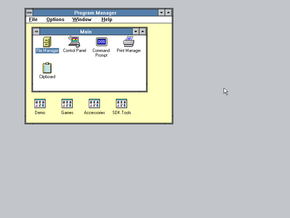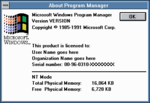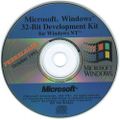User:Uncle Captain/Sandbox/7
| Build of Windows NT 3.1 | |
 | |
| Architecture | x86 |
|---|---|
| Compiled on | 1991-10-16 |
| About dialog | |
Windows NT 3.1 build 205 is a build of Windows NT 3.1 was compiled for the COMDEX/Fall '91 trade show in Las Vegas. Customary to most officially released Windows builds of the era, this build has all mentions of the build number missing from core system files. Similarly to the September 1991 build, many about dialogs display "Version VERSION" as a placeholder while winver only shows "Windows NT version 3.2". Version numbers of SDK tools suggest that this release is based on build 205.
This is the first known build to include an NT-based setup, and is one of few available early Windows NT builds (besides build 239, at least) to include a fully graphical setup on compatible hardware, a feature which wouldn't return until Windows Vista. It is also the first known build to use the NTLDR boot loader, as opposed to the earlier loader used in the September build.
Under emulation, and presumably on physical hardware, there is an issue with CD-ROM media changes that cause the File Manager and/or Command Prompt to hang. Notably, this build already had long filename support, but only under HPFS partitions. Password authentication doesn't work in this build yet, and the user cannot shutdown in Windows (so to shutdown, the user must power off the machine). Unlike the September 1991 build, this is the first build to have the BSOD as in later builds of Windows.
Setup[edit | edit source]
This build introduces a bootable installer, although it requires a SCSI CD-ROM drive connected to an Adaptec AHA-1540 or compatible adapter. In order to use the new installer, it is required to partition and format the hard disk in MS-DOS and create a boot disk using the batch files in the \SETUP directory on the installation disc by executing makedisk.bat boot A: with an empty, formatted disk inserted in the A: drive. A boot menu with SCSI IDs 0 to 7 will appear upon booting from the floppy disk. The system should boot straight to the GUI installer given that the correct ID is selected in the menu.
The older MS-DOS and OS/2 based setup batch files are also available in the \SETUP directory of the installation disc, although they have been renamed to INSTALL.BAT and INSTALL.CMD, respectively. The process is initiated by changing to the directory and executing install i386, which will install the build to the C:\NT directory. Both batch files accept the following additional optional parameters:
debug: installs the checked/debug variant of the build instead of the free/retail variant installed by defaultmstools: installs the Win32 development kit
The build requires the COM1 serial port to be present and enabled, otherwise the system will crash at boot. The port is used for debugging, however, a debugger does not necessarily have to be attached to the port. Similarly to the September release, a Sound Blaster driver (SOUND.SYS) is also included, which expects a Sound Blaster 1.0 or 1.5 (with DSP version equal to 2.0) on I/O port 0x260 and IRQ 7.
Changes[edit | edit source]
- The color palette used by the VGA driver has been changed to the same palette used by Windows 3.0. It is unknown as to what lead to this change, as both earlier and later known builds use the adjusted palette from Windows 3.1.
- The disc and the operating system itself have been updated to use the final variant of the new Windows flag logo.
- A new self-hosted installer has been added, which is based on the second phase installer of MS-DOS based Windows.
Demo applications[edit | edit source]
This build includes several demo applications for demonstrating the new operating system abilities.
Win Bez[edit | edit source]
Demonstrates the Windows NT Graphics Device Interface (GDI), the API responsible for rendering graphical objects on the screen.
Performance Meter[edit | edit source]
Measures the performance of the then-new NT kernel.
PlayIt[edit | edit source]
Illustrates the sound and music abilities of Windows generally. A version was allegedly available for Windows 3.1x Enhanced Mode as well.
Mltithrd[edit | edit source]
Demonstrates the multithreading abilities of Windows NT.




















































